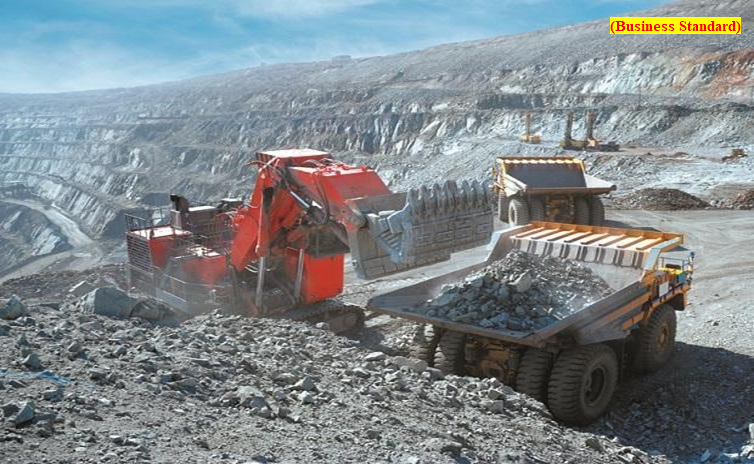India identifies copper and lithium mines in Argentina (GS Paper 1, Geography)

Why in news?
- India has identified two lithium mines and one copper mine in Argentina, and it may acquire or lease them soon. In November 2022, the Indian government sent a team of geologists to South America to ‘assess potential lithium deposits’.
Details:
- The ownership or leasing rights of the mines will be with KhanijBidesh India Ltd (Kabil). It is a joint venture of the National Aluminium Company (Nalco), Hindustan Copper (HCL) and Mineral Exploration Corporation Ltd (MECL).
- It was formed in 2019 to ensure the supply of strategic minerals in India's market.
Lithium reserves:
- Argentina is the fourth largest producer of lithium. It also has the third-largest reserve of the mineral in the world.
- Lithium is widely used in manufacturing batteries and other electronic products.
- Australia, US and China are the other major producers of the mineral.
Background:
- Kabil expressed interest in partnering with Argentina-based Camyen to prospect two areas for extracting lithium.
- Kabil also signed three agreements with Argentina government-run companies JEMSE, Camyen and YPF between July and September 2020 to explore sourcing of lithium and other mineral assets in the South American country.
What’s next?
- Kabil is also reportedly in the process of hunting joint lithium mining projects in Chile.
- In March, the JV under the mines ministry signed a memorandum of understanding with the Department of Industry, Science and Resources, Australia, for joint investment in lithium and cobalt assets in that country.
CCEA approves Rs 2,539 crore BIND scheme for modernisingDoordarshan, AIR
(GS Paper 3, Economy)
Why in news?
- The Cabinet Committee on Economic Affairs (CCEA) approved a scheme worth Rs 2,539.61 crore for Doordarshan (DD) and All India Radio (AIR), in a boost to public sector broadcasting in the country.

BIND Scheme:
- The investment, announced under the Central Sector ‘Broadcasting Infrastructure and Network Development (BIND)’ scheme, will be up to 2025-26 and will aim to modernise the two entities run by Prasar Bharati.
- It is also the largest investment outlay by the government for the two public broadcasters under the BIND scheme.
- The BIND scheme is the vehicle for providing financial support to Prasar Bharati for expenses related to expansion and upgrade of its broadcasting infrastructure, content development and civil work related to the organisation.
- Prasar Bharati, as the public broadcaster of the country, is the most important vehicle of information, education, entertainment and engagement for the people, especially in remote areas of the country, through DD and AIR.
High-quality content:
- Another priority area of the scheme would be the development of high-quality content for both domestic and international audiences and ensuring availability of diverse content to viewers by upgrade of capacity of DD Freedish, the free-to-air DTH platform run by Prasar Bharati, to accommodate more channels.
- Purchase of OB vans and digital upgradation of DD and AIR studios to make them high-definition-ready would also be done as part of the project.
Way Forward:
- The BIND scheme would enable the public broadcaster to undertake major upgrade of its facilities across the country.
Why is Southern Hemisphere hit by so many storms?
(GS Paper 1, Geography)
Why in news?
- The Southern Hemisphere was rocked by some of the devastating storms in 2022 that raged up to category 4. The region is about 24 per cent stormier than the Northern Hemisphere, but until now no one knew why. Scientists have now found the answer.

Key Findings:
- Researchers at the University of Chicago have found that the ocean circulation and the large mountain ranges in the Northern Hemisphere are the big triggers that make the Southern Hemisphere prime to be hit by storms and cyclones on an annual basis.
- They also found that this storminess asymmetry has increased since the beginning of the satellite era in the 1980s.
- The findings indicate that the increase in storminess is consistent with climate change forecasts from physics-based models. Researchers said that consistently, the Southern Hemisphere has a stronger jet stream and more extreme weather events than the Northern Hemisphere.
- They also observed that the Southern Hemisphere is getting even stormier, whereas the change on average in the Northern Hemisphere has been negligible. The Southern Hemisphere's storminess changes were connected to changes in the ocean.
Approach:
- They tested the topographic parameters and found that large mountain ranges, which are more in the Northern Hemisphere, disrupt airflow in a way that reduces storms in the region.
- To test the theory, they flattened every mountain on Earth in the numerical model, and about half the difference in storminess between the two hemispheres disappeared.
- They then moved to water circulation as it creates the energy difference between the two hemispheres. As they eliminated this conveyor belt, they saw the other half of the difference in storminess disappear.
Background:
- Hurricane Ian became the worst tropical storm to hit the Southern Hemisphere in 2022. The storm hammered Florida with such ferocity that it wiped out whole neighborhoods, tossed boats onto highways, swept away beaches, and swamped homes in roof-deep waters.
- It killed more than 100 people, the majority of victims in Florida, making it the third-deadliest storm to hit the U.S. mainland this century.




